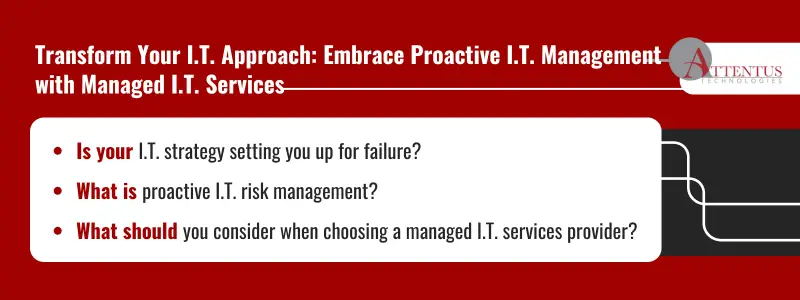How long will you continue reacting to problems instead of preventing them?

Why do I.T. issues always arise at the worst possible time? A critical file server goes offline, a computer breaks down, a virus affects your systems, or your network slows to a crawl just as you finalize a crucial project. As you scramble to fix these problems, your competitors keep moving forward. What are they doing differently?
Most businesses rely on a “break-fix” approach, only addressing I.T. issues after they cause disruptions. This strategy is expensive, stressful, and ultimately unsustainable.
Why rush to put out fires when you could prevent them from starting?
Enter proactive I.T. management.
Using the latest artificial intelligence (AI) models to monitor your technology ecosystem 24/7, you can predict when an undesirable event is likely to occur and promptly take preventative measures.
Sounds complex? Don’t stress. A reliable managed services provider (MSP) can deliver proactive I.T. support to ensure business continuity no matter what comes your way.
Here’s what you need to know about successfully switching from reactive to proactive I.T.:
What’s the Real Cost of Reacting to Problems Instead of Preventing Them?
#1. Impact on Customer Experience
Picture this: A piece of hardware hosting critical files suddenly breaks down, and you lose all customer data. Or a crypto-jacking infection on your web server causes your site or applications to become unresponsive. By the time you rectify the issue, your clients are already feeling the pinch. How long will they stick around if frequent downtime affects service delivery?
In an era where customers expect seamless digital interactions, even minor inconveniences impact brand perception. Are you ready to lose loyal customers to competitors, miss growth opportunities, and watch profit margins dwindle?
#2. Impact on Employees
What happens to employees when I.T. issues occur daily? Do they accept it, bypass inefficient processes with shadow I.T., or leave for a company with better systems?
Over time, even “minor” delays compound into lost hours, reduced morale, and increased frustration.
If employees resort to shadow I.T., hackers can use it as a backdoor for attacks. If they leave, the cost of replacing them—including hiring and onboarding—can reach $225,000 per role, according to Forbes.
Reactive I.T. management doesn’t just hurt systems—it drives away talent.
Get Rid of All Your I.T. Issues with Attentus TechnologiesStop reacting to problems—work with an MSP that keeps your systems running right. |
#3. Impact on Security
Today’s cyber threats are more advanced than ever, often hiding undetected for months while causing significant damage.
Without ongoing system vulnerability scanning and monitoring, threats can stay undetected on your network for 197 days or more. What damage would this cause to your business? Could you recover?
It’s time to stop playing firefighter. Proactive I.T. management is the solution.
Proactive I.T. Management: Achieve More Without Constant Headaches
Proactive management is about preventing I.T. issues, not waiting for something to break to fix it. This I.T. infrastructure optimization model involves a digital strategy roadmap, consistent backups, pre-emptive fixes, regular updates, and continuous monitoring of your technology ecosystem.
What will adopting a proactive culture mean for your business?
- With systems to provide backups and redundancy, downtime and its impacts on service delivery will be minimized, leading to better customer experiences.
- Streamlined processes will directly improve I.T. performance, reducing the number of support tickets. This means employees can be more productive.
- Bugs, viruses, and other security issues will be much less likely to catch you unaware.
- Your I.T. budget will dramatically reduce over the long run since fewer issues need to be fixed.
Regarding reactive vs. proactive I.T. management, there’s no debate about which strategy is better. The question is whether to leverage internal resources or consider I.T. outsourcing. For small and medium-sized companies lacking a fully-fledged tech team, leveraging managed service provider benefits can save time and money by allowing them to focus on core objectives.

I.T. Outsourcing: Finding The Right Partner
When choosing between MSP I.T solutions, consider these questions:
- Is the provider qualified and knowledgeable, with many years of experience?
- Can they tailor their service to your business?
- Do they provide a quarterly SLA compliance report? This should be a non-negotiable expectation.
- Are they friendly, approachable, healthy, and available 24/7
- What’s their approach towards preventing I.T. issues from recurring?
- Is their service within your budget?
By carefully evaluating potential MSPs against these metrics, you can find a partner who gives you operational peace of mind.
Start Your I.T. Transformation Now with Attentus
With over 20 years of experience providing hands-on, friendly, proactive I.T. services, preventative I.T. maintenance is second nature to Attentus. We make I.T. simple, efficient, and aligned with business objectives from day one, so you never have to call us to patch things up. At Attentus, we’re committed to delivering exceptional results and building trusted relationships, which are at the heart of everything we do.
Ready to stop playing firefighter? Schedule a custom consultation now and move forward in control.
